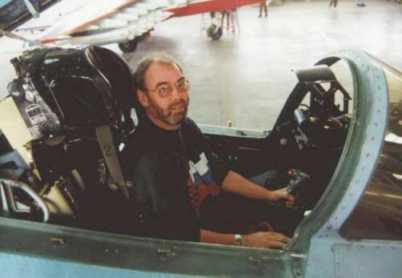 .
.
The prototype Sukhoi T-10 made its maiden flight on 20 May 1977 from Zhukovskii just outside Moscow. After early flight trials revealed some unacceptable aerodynamic characteristics, the airframe was re-designed into the T-10S which first flew on 20 April 1981 and this is the aircraft that we would recognise today.
Known at first in the west by the applellation RAM-K (based on US Satellite imagery taken over the wrongly named Ramenskoye air base that is now known to be called Zhukovskii) it was assigned the NATO reporting name of Flanker-B by the Air Standards Co-ordinating Committee (the original T-10 prototypes thus becoming Flanker-A’s).
First close-up photographs of the Flanker-B appeared in the western press after an over-enthusiastic Flanker pilot collided with a Norwegian P-3 Orion that he had been shadowing, fortunately without injury to both crews.
Since that time the Flanker has been seen at numerous airshows around the world and has impressed western aviation experts with its amazing agility and incredible manouevres such as the tailslide, Cobra and Hook.
The number of variations of the basic design continues to grow, with tandem two-seat trainers (Su-27UB), canard equipped naval fighters (Su-27K), multi-role fighters with canards, new radar, taller fins etc (Su-35 ‘Super Flanker’), tandem two-seat multi-role developments of the trainer (Su-30/M/MK), thrust-vectoring developments of the Su-35 (Su-37), side-by-side strike aircraft (Su-34/32FN) and thrust-vectoring tandem two-seat fighter-bombers fitted with canards (Su-30MKI) ordered by India.
The aircraft has been exported to China, Vietnam and India and is in service with the Ukrainian and Belorussian forces. It is reportedly contending for an Indonesian order and the Israelis are supposed to be operating a couple of ex-Belorussian machines.
For the full background of the Su-27 Flanker and all its variants - see my Flanker website .
Models
The Flanker has not been well served by the plastic kit manufacturers, probably because it is a former Soviet Bloc aircraft and it was thus difficult to obtain accurate data about it, but the type has now been thoroughly documented so there should be no excuse for producing inaccurate kits - indeed I had the privilege of actually sitting in a Flanker at the once top secret Russian airbase at Kubinka, home of the Russian Knights
 .
.
In doing this survey I have used drawings from a number of sources, both Russian and western, the two main ones being from the Russian Polygon books on the Su-27 family and the Su-34 ‘Strike Flanker’. From the west, the best drawings I have come across are those to be found in the excellent Flanker profiles produced in the World Airpower series. A full list of references is at the end of this article.
More important than exact dimensions, at least to my mind, is the overall ‘look’ of the finished model. The Flanker has a distinct shape, with large underslung engine nacelles, a slim, curved forward fuselage that looks like some predator about to strike, and tall twin fins. It is this shape that most of the kits currently available have failed to capture, either being too big around the nose area or with intakes that are too shallow.
Most of the kits are also short in fuselage length - some seriously so. I think that this shortfall stems from a misinterpretation of the published dimensions of the Flanker. The usual figure given for the overall length is for the fuselage EXCLUDING THE NOSE PITOT PROBE but most kit manufacturers have taken the length as including the probe with a consequent shortness in the fuselage.
The published dimensions for a Flanker are :-
| Su-27 | 1:144 scale | 1:72 scale | 1:48 Scale | 1;32 Scale | |
| Length | 21.93 | 152mm | 304mm | 457mm | 685mm |
| Span | 14.7 | 102mm | 204mm | 306mm | 459mm |
All variants of the Flanker (except the new Su-27KUB) have the same
wingspan, but the length varies -
the Su-27K naval version has a length of 21.185m, the Su-35/37 is 22.2m
and the Su-34/32FN is 23.3m.
The Su-27KUB/Su-33UB side-by-side naval trainer has the same length as the Su-27K/Su-33, but the span is increased to 16.00m
Note that the length dimension is without the nose pitot probe and the span includes the wingtip launch rails :-
So armed with some drawings and dimension figures, lets check out
the
available Flanker kits:-
Currently Available
Kits...........................
| Scale :- | 1:144 Scale | 1:72 Scale | 1:48 Scale | 1:32
Scale |
| Other Scales | References | Accessories |
| Manufacturer :- | Revell (Kit No 04084) |
| Scale :- | 1:144 |
| Variant :- | Su-27 Flanker-B |
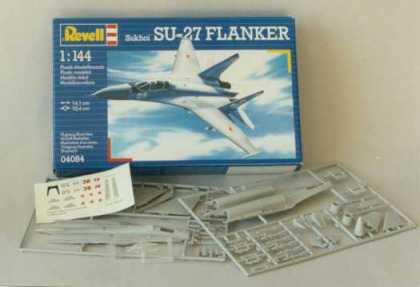
Decals
Markings for two aircraft ‘Blue 05’ and ‘Red 36’. The sheet includes six red stars, a black anti-glare panel (totally inappropriate) and decals for dark grey dielectric aerials on the fin tips and starboard fin leading edge - which is totally wrong. The decals are well printed in matt.
Accuracy/Construction
Span is almost spot on, length 15mm too short, all of it in the forward fuselage. Wing leading edge is too swept which results in a lack of chord at the wing tip. The wing trailing edge is OK. Horizontal tailplanes are OK - just a little short in chord. Vertical fins are adequate but lack the leading edge intakes and have a strange ‘lump’ above the rudders to represent the aerials. The ventral fins are too deep and wrongly shaped and the engine intakes are far too shallow. In side profile it looks like the T-10 prototype and lacks the distinctive curved spine and nose-down look of the real thing.
The main undercarriage legs, wheels and doors are adequate (although the bracing strut on the main leg should be to the rear and at a shallower angle - try reversing the legs). The nosegear consists of a leg with a separate fork and wheel plus a mudguard (part 35) which isn’t mentioned in the instructions ! The nose-gear doors are totally wrong, consisting of two mouldings which are meant to be cut in half to give two small front doors and two larger rear doors. If the doors are not cut in half and the front portion is cemented closed, a slightly better representation can be achieved. The nosewheel is represented by a simple doughnut shape with no hub detail.
The dorsal airbrake is a separate item and the armament comprises what purports to be six AA-10 Alamos and their asociated pylons - all totally inaccurate. The wingtip pylons are represented as simple pods.
Cockpit detail is non-existent and the clear canopy is the wrong shape - it is too tall and ‘humped’ and has the IRST (Infra-Red Search and Track) ball moulded far too small and offset to starboard.
Overall the kit is well moulded with 47 parts in light grey plastic with fine engraved panel detail but the overall shape seems to indicate that it was tooled from early references and shows signs of being something of a cross between the early T-10 prototype Flanker-A and the later, re-designed, T-10S Flanker-B.
The engine bulges on the upper fuselage extend all the way to the airbrake and the tailcone is a distinct pod - rather than being an extension of the spine. The leading edge root extension (LERX) meets the fuselage at a sharp angle instead of a smooth curve and the underside of the LERX/fuselage has a strange shallow vee shape which meets the circular nose radome with a vee-shaped groove !
Other detail oddities are the two fictitious exhausts either side of the airbrake (best filled in), the cover over the gun port (reduce in size), the two pods (parts 11 & 12 - which are shown on the instruction sheet as being attached to the outer fins, they do in fact contain the main gear lock-down mechanism and should be attached to the lower nacelles as shown in the painting three-view), the protrusions on the lower wing (remove), the bulges above the rudders (remove) and the anti-flutter weights on the fin leading edge (remove).
General
This kit was obviously the first attempt at a Flanker in this scale and it shows. It would take a fair amount of work to make it into an accurate replica.
![]()
| Manufacturer :- | Dragon (Kit No 4557) |
| Scale :- | 1:144 |
| Variant :- | Su-27 Flanker-B ‘Russian Knights’ |
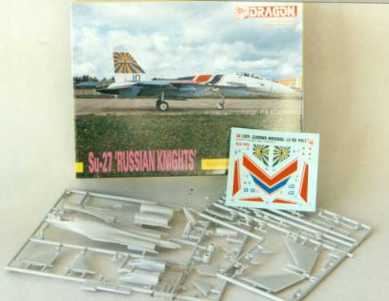
Decals
Markings for the Russian aerobatic team the ‘Russian Knights’ featuring the wing/spine/tailplane chevrons, the fin ‘sunburst’, four stars, the squadron badge and the Sukhoi OKB logos. The decals are well printed and include the ‘Russkiye Vityazi’ in Cyrillic script and tail numbers for two aircraft 07 and 10. This kit has also been re-released with different decals for a ‘standard’ Flanker and a Chinese PLAAF machine and with extra parts as a ‘Naval Flanker’.
Accuracy/Construction
The kit has 44 parts moulded in light grey plastic with fine engraved panel detail plus a clear sprue with a one-piece canopy/windscreen.
Arriving later on the scene than the Revell kit, I had hoped that this kit would at least be accurate - which it nearly is, but not in 1:144 scale ! This kit is seriously undersized.
Both the span and length are too short by 12mm, so based on the kits’ wingspan, I reduced my drawings to match and compared it to those. As a 1:163 scale kit it is not too bad - it is still too short and narrow around the nose and the fuselage is too straight in profile. It has a curious ‘kink’ just behind the non-opening airbrake. The fuselage/LERX blending is captured well although the engine nacelles extend too far forward on the upper fuselage.
The wing shape is good, although a little too short in chord whilst the vertical fins, complete with intakes, are spot on. The horizontal stabilizers are far too small but the intakes are good in depth. The ventral fins are too deep.
The undercarriage is good with well detailed main legs and correct doors and a one-piece noseleg complete with debris guard. The nosewheel door is the correct shape but lacks the emergency pneumatic reservoir bottle on the inside face. Included on the sprue are the twin wheels, noseleg and arrestor hook for the naval variant.
Armament comprises six AA-10 Alamos which are well moulded and reasonably accurate except for their forward fins which lack the unique inverse taper. Eight pylons are supplied although the construction diagram only shows four of them fitted - the Knights usually fly with all the pylons in place, but not the missiles.
Cockpit detail is provided in the form of a lump of plastic shaped a little like a reclining robot in an armchair, which is probably adequate when painted. The canopy is moulded in tinted plastic which is wrong although the overall shape is not too bad. The prominent IRST ball is moulded in with the fuselage and is not therefore transparent.
General
Taken as a 1:144 scale kit, this offering is woefully undersized but
as a 1:163 scale kit it is not bad and almost captures the look of the
original. But put it alongside a 1:144 scale MiG-29 Fulcrum from the
same
company and it is almost the same size, whereas in real life the
Flanker
is a much bigger machine.
![]()
| Manufacturer :- | Dragon (Kit No
4584) |
| Scale :- | 1:144 |
| Variant :- | Su-35 & Su-37 'Super Flanker’ |
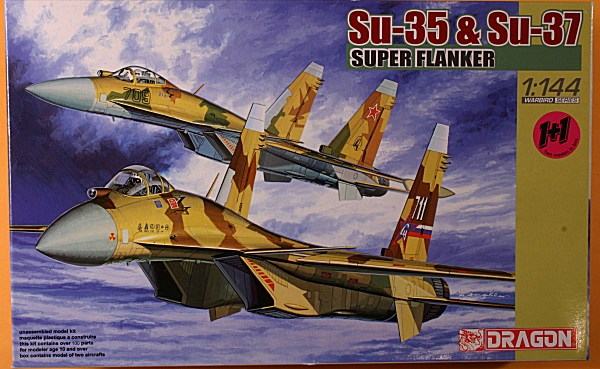
| Manufacturer :- | Trumpeter |
| Scale :- | 1:144 |
| Variant :- | Su-34 'Strike Flanker’ |
 |
 |
| Manufacturer :- | Planes |
| Scale :- | 1:72 |
| Variant :- | Su-27 Flanker-B |
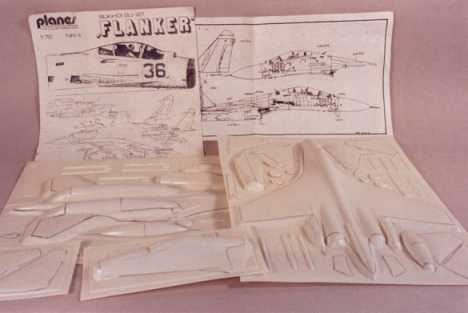
Decals
None.
Accuracy/Construction
This Hungarian kit is probably no longer available and has been overtaken by the injection moulded versions but I have included it here for nostalgic reasons because it was the kit that started my continuing love affair with the Flanker. Moulded on two sheets of thick white plastic it consisted of a complete one-piece upper fuselage and wings, a lower fuselage complete with nacelles and horizontal stabilisers, separate lower wing halves, two-part intakes, fins, nosecone, ventral fins and exhaust nozzles plus a clear canopy complete with IRST ball.
The wheels were each moulded in two halves and even the undercarriage legs and weapons pylons were vacform moulded, as were five AA-10 Alamos, two AA-11 Archers and a data acquisition pod.
Although a little crude in places, with missiles and undercarriage that needed replacing, it was nevertheless ACCURATE and came out a couple of years before any injection moulded kit. You had to scratch build the cockpit, undercarriage and armament, but that was half the fun.
The same enterprise later released a conversion set for their Flanker, consisting of a new two-seat forward fuselage moulding, canopy and taller vertical fins to make the Su-27UB - surely the first time there has been a vacform conversion set for a vacform kit !
General
This was a very competent attempt at the Flanker and it achieved an accuracy not yet matched by any of its injection moulded rivals - at least in this scale.
![]()
| Manufacturer :- | Revell (Kit No 4376) |
| Scale :- | 1:72 |
| Variant :- | Su-27 Flanker-B |
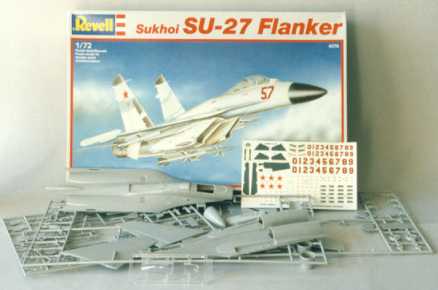
Decals
The decal sheet has black-outlined red numbers 0 -9 allowing any combination of side numbers to be modelled - although all the references I have seen show white-outlined numerals. Six red stars, stencil data and the small grilles on the intakes are all included, as are some crude instrument decals for the side consoles and instrument panel. The sheet is finished off with dark grey panels for the fin tips and leading edge plus the gun blast panel on the starboard side. These areas are either white on later aircraft or green on earlier machines whilst the gun blast panel is bare metal. The decal sheet is printed in matt and is ‘generic’ rather than being applicable to a specific aircraft.
Accuracy/Construction
The kit contains 89 parts moulded in light grey plastic with engraved panel detail. A clear sprue contains a separate windscreen/canopy.
This was the first injection-moulded kit in this scale and is a re-issue by Revell of the TSUKUDA kit. It appears to be scaled-up from the 1:144 version and suffers from that kits’ inaccuracies (or maybe the 1:144 kit is the 1:72 version scaled down ?) The parts layout is the same in both kits and even the panel lines match.
Wingspan is about 4mm too great - even without the wingtip launch rails. Whilst the trailing edge matches the drawings, the leading edge is too swept and results in a lack of chord at the tips. There is a moulded bulge on the wing underside which extends beyond the trailing edge. This has a zipper-like groove in it which I presume is meant to represent some kind of wing-fold line. The whole arrangement is incorrect and should be removed.
The whole front fuselage is too short forward of the wing
roots
which makes the cockpit too far back and the tip of the nose 20mm too
short.
The forward fuselage/LERX junction has a pronounced groove rather than
meeting in a smooth curve and the nose cone is far too bulbous.
Included
in the kit is a six-part arrangement of circular discs, a spike and
bracing
struts which is meant to represent some kind of radar antenna which
fits
inside the nose. The whole thing is best left on the sprue !
The upper engine nacelles blend into the fuselage around the dorsal
airbrake rather than being distinct bulges that end in line with
the fins and there are two ficticious outlets on either side of the
airbrake.
The airbrake itself is the correct length, but it is too wide and there
is moulded detail in its recess - all totally ficticious. The spine
blends
into the upper fuselage and there is a separate ‘bullet’ to represent
the
tailcone rather than the tailboom being a continuation of the spine.
The
tailboom is also 13mm too short.
The tailplanes are almost correct in shape and size but are mounted too high relative to the wing in side view. The side booms onto which they are fitted are too high.
In profile the spine does not have the kink of its smaller scale brother but the whole fuselage is too straight and lacks the distinct nose-down curve of the real thing.
The underside of the forward fuselage has an incorect vee-shape and where the vee meets the nosecone there is a strange ‘step’. The intakes are far too shallow - being almost half the depth they should be and they have an insert, presumably to represent the anti-FOD grille , but this looks like a louvred shutter with horizontal slats.
The fins are OK in shape but are too tall and lack the intakes at
the
base of the leading edge. They do however, have a totally erroneous
bulge
above the rudders and the trailing edge has a curve at the base rather
than the correct tailplane actuator cover. The port fin has a spike
extending
from the upper leading edge - which is not big enough to be the
anti-flutter
balance of the early T-10S prototypes and it is not present on
production
Flankers, so it is best removed.
The ventral fins are too deep and have a leading edge that is too swept
and the jetpipes are crude with deep grooves representing the petals.
The cockpit is entirely wrong, with a floor, side consoles, a ‘stick’, front and rear bulkheads and an instrument panel. The canopy is far too big and tall whilst the windscreen features an offset IRST ball which is incorrect. The crude seat is constructed from three parts and bears no resemblance to a K-36 ejection seat. The undercarriage consists of two main legs - with bracing struts at the front rather than at the rear - whilst the noseleg is a strange levered-suspension affair with twin wheels - all totally incorrect. The mainwheels are the correct diameter but the hub detail is wrong. The mainwheel doors are almost acceptable but the nose door comprises four pieces instead of the single large door on the real thing.
Underwing stores comprise six missiles which look vaguely like AA-10 Alamos but are far too small, two AA-8 look-alikes and four totally unidentifiable missiles. The inner pylons are almost useable but the wingtip ones look like landing skis !
General
This kit is a caricature of the Flanker and bears only a passing resemblance to it. It would take a great deal of work to make it into a decent replica (see my article ‘Fixing Flanker’ in SMI October 1989) and it has been superceded by later kits.
The Revel Su-27 has also appeared under the Tsukuda and Kangnam labels - different boxes, same kit.

![]()
| Manufacturer :- | Italeri (Kit No 187) |
| Scale :- | 1:72 |
| Variant :- | Su-27 Flanker-B |
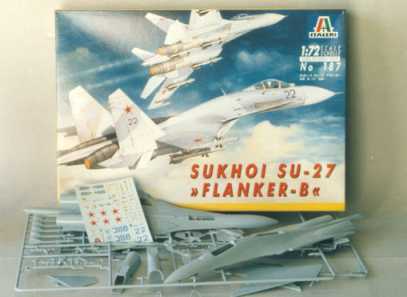
Decals
Markings are provided for two variants - ‘Blue 388’ the Sukhoi demonstrator that has been seen at numerous airshows around the world and ‘Blue 22’ an unidentified operational machine. The demo version includes two Sukhoi stylised ‘CY’ logos and Viktor Pugachevs name in Cyrillic (he of the ‘Cobra’ fame). The rest of the sheet comprises six red stars, decals for the grilles on the intake sides, tailplane incidence markings and a lot of other stencilling. The decal sheet is printed in matt and apart from the ‘scum’ that comes off when the decals are immersed in water, is very well done.
Accuracy/Construction
Moulded in light grey plastic with fine raised panel detail, Italeris’ Flanker consists of 91 parts plus a clear HUD lens, separate windscreen/canopy and IRST ball.
Wingspan and shape are spot on but the overall length is just 4mm too short. However, the nosecone is too bulbous and the whole fuselage forward of the wing is too wide and deep which spoils the appearance of the whole model. The spine is accurate and continues to form the tailboom which is correct but the shape of the box fairings on either side of the boom is not right - the box is continuous in plan view and does not have the ‘step’ as moulded by Italeri. The airbrake is openable and has the correct shape and size.
The rear fuselage is about 2mm too wide which makes the overall tailplane span correct but individually they are each about 1.5mm too short in span and are a little lacking in chord. The rear triangular fairings on the tailplanes are also a little too wide and the whole tailplane is mounted 2mm too far forward.
The fins are spot-on and have the correct leading edge intakes, whilst the ventral fins are a little too deep - not too much, it just depends which drawings you compare them with.
The intakes completely let this model down. They are far too shallow in side profile by about 3mm which totally alters the appearance of the model. They are well moulded with a separate insert for the wheel well and upper ramp. The jetpipes are OK and make an attempt at capturing the double-walled appearance of the original. A separate afterburner ring is supplied.
Cockpit detail is good and consists of a bathtub with moulded detail on the side consoles, a detailed instrument panel, a nicely done control column and a three-part facsimile of a K-36 ejection seat. The hatched fairing behind the seat is separate - which is useful if you want to depict the canopy in the raised position - the fairing rises with the canopy. The canopy itself is thin and crystal clear. It is a little too big - as is the cockpit aperture in the fuselage - being too long and deep although the overall shape is good. This size problem is a result of the whole forward fuselage being too wide. The windscreen is likewise too wide but it does have a separate IRST ball - a useful feature if you are doing conversions which don’t have it (P-42, T-10-20) or those which have it offset to the right (Su-27K, Su-35 etc).
The undercarriage on this kit is superb, with correctly moulded main legs with all the actuators in the right place plus the locking pin that fits into the fuselage fairing. The noseleg is made up from five pieces plus a separate wheel and looks a bit anaemic but is adequate. It features a simplified anti-FOD mudguard and has separate parts for the actuating rods. The undercarriage doors are all correct in shape and size with the nosedoor having a separate pneumatic reservoir bottle. Each mainwheel is in two halves and whilst being slightly undersized, they do have correct hub detail. The detail parts on this kit are very good - all the undercarriage door actuators are provided as are all the air-data probes, spine aerial and the intake mounted RWR antenna, though the latter are a little on the thin side.
Underwing stores comprise just six AA-10 Alamo missiles - four radar and two IR versions but they are all too short and the inverse-tapered forward fins are depicted as having straight leading edges. The six wing pylons look vaguely like APU-470 pylons but they are far too small and thin. The Su-27 has pylons for the Alamos on the belly and intake stations that are different to those on the wings - Italeri have moulded them all the same shape. No provision is made for the outer wing pylons nor their associated AA-11 Archer missiles whilst the wingtip pylons are totally incorrect - being too long and thin with inadequate depth.
General
I used to like this kit - it was the cheapest around and was almost correct. It is let down by an inaccurate nose and too shallow intakes which combined with the too large canopy make it look distinctly odd and totally unlike a Su-27. In detail and fit it is good and formed the basis of many of my early Flanker conversions. Its box art is second only to Hasegawas for style.
![]()
| Manufacturer :- | Italeri (Kit No 197) |
| Scale :- | 1:72 |
| Variant :- | Su-27 ‘Sea Flanker’ |

Decals
Markings are provided for ‘Blue 39’, a Su-27K (T-10K-2) which made the first successful landing on the Russian aircraft carrier Tbilisi in November 1989 piloted by Viktor Pugachev. Also included on the sheet are two AVMF flags and two ‘CY’ Sukhoi logos - neither of which is applicable to ‘Blue 39’ as it was marked for the trials. In any case the blue should be much darker - not the medium blue that Italeri have used. The rest of the sheet is the same as their land-based version with six red stars and stencil data.
Accuracy/Construction
Sticking canards and twin nosewheels on a standard Flanker does not a Su-27K ‘Sea Flanker’ make, which is what Italeri have tried to do with this kit.
The canards are simply butt-joined to the forward LERX which is totally incorrect - the real thing has a substantial ‘shoulder’ extending from the wing root onto which the moveable canards are attached.
A new noseleg is provided plus twin wheels - all of which is
adequate
if a little simplified. The landing light arrangement on the noseleg is
as standard which is also incorrect. A tail hook is provided but this
is
the wrong shape and section.
Given the inaccuracies of the basic kit, this version will not make
up into a reasonable replica of a naval Flanker - much more work is
needed
for that. See my Su-27K conversion at Linden
Hill.
The same comments applied to the ‘standard’ Flanker kit apply to the
rest of this kit.
General
Again, a half-hearted attempt to create a different variant based on an already flawed kit.
I have also recently found the Italeri kit re-issued in the following box :-

I don't know the manufacturer, the logo appears to read W or I-V House, with no other indication as to who this is or where it is produced. However, it is a crude reissue of the Italeri kit.
![]()
| Manufacturer :- | Nakotne (Kit No NE-7005-1) |
| Scale :- | 1:72 |
| Variant :- | Su-27 Flanker-B |

Decals
Crudely printed in gloss, the sheet contains an instrument panel (a blue shape with black ‘blobs’), bort numbers for two aircraft - ‘Blue 36’ and ‘Red 14’, a single ‘winged archer’ Sukhoi logo, six red stars, four grilles for the engine intakes and a few stencils. Coming as it does from a fledgeling injection moulded kit company, the decals are not up to the standards we have come to expect, but there are plenty of replacements to be found amongst the specialist decal manufacturers.
Accuracy/Construction
Comprising 90 parts moulded in white plastic with deeply engraved panel detail plus a clear sprue containing a separate canopy/windscreen plus a HUD and three taxy-light lenses.
Span is 10mm too great although the overall wing shape is good. The leading edge slats and trailing edge flaps are moulded separately - which is useful if you want to depict them deployed.
The fuselage is 6mm too short at the front - the shortfall occuring somewhere between the cockpit and the wing leading edge whilst the rear fuselage is 3mm too short between the wings and tailplanes making the whole fuselage look foreshortened. The tailplanes are correctly shaped but the rear fuselage is 4mm too wide making the fins too far apart. Separate actuator covers are provided which facilitates drooping the tailplanes.
The side profile is good with correctly shaped spine and nosecone. The airbrake is separate with its own actuating ram and the intakes are the right shape and depth - although the lips would benefit from being thinned down. The intakes have a separate roof and wheel well with suction relief doors moulded on the undersides. An insert for the compressor face is included as is an anti-FOD ramp - although this should be mesh, not a solid door. The fins are correct with leading edge intakes and separate rudders - another useful feature.
The jetpipes are a little crude with only grooves to represent the petals, although there is an insert with the afterburner flame holders moulded onto it. The ventral fins are almost spot on.
The cockpit is rather crude with a floor and two rectangles to represent the side consoles. An instrument panel is included as is a rudimentary control column. A one piece ‘lump’ to represent the K-36 ejection seat plus a rather indistinct pilot complete the cockpit area. The canopy is correctly shaped though a little thick and provision is made for mounting it in the open position by means of a little lug which fits into a separate rear fairing. No provision is made for the decking behind the seat to open with it though.
The windscreen is well shaped but again, a little thick with an
integrally
mouled IRST ball that is a little on the small side.
The undercarriage is simplified with mainlegs devoid of any actuators
or scissor links whilst the noseleg features a separate fork and rear
strut.
Clear landing light are provided. All three wheels are undersized and
the
separate nosewheel mudguard is inaccurate. The undercarriage doors are
well shaped but lack any form of actuating mechanism, nor does the
nosedoor
have the pneumatic reservoir bottle on its inside face.
Armament consists of four AA-10 Alamo-C long-burn missiles, two AA-10 Alamo-B short-burn missiles and four AA-11 Archer close-range missiles and their associated pylons. The missiles are reasonably accurate - as are the pylons, different pylon shapes being correctly provided. Final details include the nose probe, the air data probes, the Odd Rods IFF aerials, the RWR antenna on the intake sides and the bulges for the main undercarriage locking mechanism.
General
This is a competent attempt at a Flanker that is let down by the deeply engraved panel detail reminiscent of Matchbox at its worst and the rather crude undercarriage. The shortness in the fuselage is not readily apparent unless the model is placed next to other kits but it is almost impossible to correct. The separate control surfaces are a bonus though, if you want them deployed. I purchased my kit in Russia where it was very cheap. It is now available in the UK with an increased price and has been taken up by Encore and re-issued in a flimsy box with a new decal sheet and instructions with a consequent hike in price to more than double the Nakotne UK price. It has also been re-issued in new boxes with new decals by a Russian firm called 'Berkut' - see later.
![]()
| Manufacturer :- | Nakotne (Kit No 7006) |
| Scale :- | 1:72 |
| Variant :- | Su-35 |
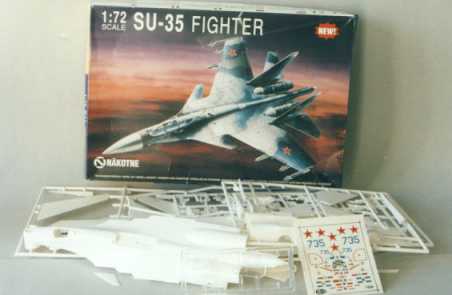
Decals
Gloss printed decal sheet with six red stars, an instrument panel, two ‘winged archer’ Sukhoi logos, some unreadable stencilling and side numbers for ‘Blue 735’ which is probably ficticious - the prototype Su-35’s have had outline-only numbers in the 700 series but the highest seen so far is 711 (the prototype Su-37). The whole sheet is better than that in the Su-27 kit but is best replaced from a specialist sheet.
Accuracy/Construction
This is exactly the same kit as the Su-27 variant but it has been re-tooled and now features fine raised panel detail where before it was deeply engraved. The upper and lower fuselage halves have been altered to incorporate the revised forward LERX and the mountings for the canards. The overall shape is correct with deep shoulders and accurate canard surfaces but the shortness of the front fuselage is even more noticeable with the canards being mounted too near the wing leading edge. If the fuselage could be separated in front of the airbrake and a 6mm plug inserted forward of the wing and a 3mm plug aft of the wing, the model would be spot-on for shape.
The rest of the kit is exactly the same as the standard Su-27 kit except for the provision of a rudimentary refuelling probe, a hemispherical antenna for the spine, a nose tip instead of a probe and a new windscreen with offset IRST ball. But even with these changes it is still not a Su-35. It lacks the taller ‘wet’ fins with square tips, the reprofiled radome, the revised tailcone shape and the twin nosewheels.
With a bit of work to correct the length of the forward and rear fuselage it could be made into an early Su-35 prototype, the Su-27M (T-10-M1) which did have a single nosewheel and standard fins but you would still have to re-shape the radome. The kit has been re-issued by Encore with an excellent decal sheet containing outline-only numbers for aircraft 703 to 706 (and by reversing the six, you could make 709), six red stars, a winged archer logo plus lots of stencil data. This is a useful and so far, only source of these outline numbers used by the Su-35 prototypes, but whether the decal sheet alone justifies the massive price increase is best left to the buyer.
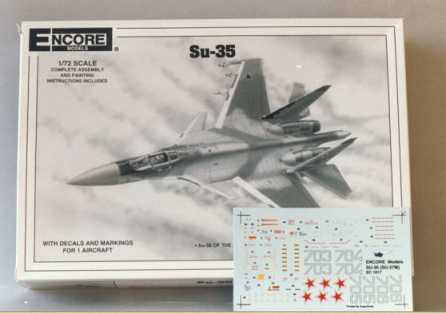
When I first received this kit to review I thought that, at last, we had a model of a third generation Su-35 Flanker but alas it falls short of that goal. It is the only single-seat kit on the market with canards (excepting Italeris’ inaccurate Sea Flanker) but it would take a lot of work to turn it into a passable replica of a ‘Super Flanker’.
![]()
| Manufacturer :- | Nakotne (Kit No 7008 etc) |
| Scale :- | 1:72 |
| Variant :- | Su-30MK,Su-30 & Su-27UB |

My kit of the Su-30MK/Su-30 contained the decal sheet from the companion Su-27UB Trainer kit (which I don’t have to hand) so I can only comment on the quality of that sheet. It is gloss printed in Italy by the same people who make the Italeri decal sheets so the quality is good. The Su-27UB decals comprise six red stars, nose and tail bort codes for ‘Blue 109’, two ‘winged archer’ logos, decals for the front and rear instrument panels (although these are a different shape to the plastic panels in the kit) and a reasonable amount of stencil data.
The instruction sheet in the Su-30MK/Su-30 kit shows what the decal sheet should have been and this contains six red stars, two ‘CY’ and two ‘winged archer’ logos, two instrument panels, stencil data, numerals 501 - allowing for bort numbers ‘Blue 50’ or ‘Blue 51’ - two early production Su-30’s and finally, a Russian flag for the aircraft’s spine.
Accuracy/Construction
The kit contains the same sprues as the Su-27 Flanker-B kit with the single-seat fuselage moulding replaced by a new two-seat fuselage sprue that also contains a second pilot, control column, cockpit bathtub and instrument panel plus a crude in-flight refuelling probe. A further new sprue contains the taller fins of the two-seater, although they are not quite tall enough, being some 2mm too short.
Overall the outline is not too bad and captures the fuselage shape quite well, although it is still 9mm too short in overall length which isn’t so readily apparent on this kit.
The same comments about the Su-27 kit are applicable to the rest of this kit except for the armament.
As well as the ‘standard’ sprue containing the air-to-air missiles, this kit contains a new sprue with parts for two Ch-59M (AS-18 Kazoo), two Ch-35 (AS-20), two S-25L Laser Guided Rockets and an ARK-9 data-link pod. These air-to-ground weapons appear to be accurate and form a welcome addition to this kit. To my knowledge, this is the first time that these weapons have been available in kit form.
A new clear sprue contains a windscreen with offset IRST ball (but there is no mounting platform for it on the fuselage), the larger two seat canopy, two HUD’s and two taxy light lenses.
General
This is one of only two 1:72 scale tandem two-seat Su-27 kits on the market and it is a reasonable effort with a good decal sheet and armament fit, but it does not knock the Heller two seater from its ‘best Su-27UB’ perch.
![]()
| Manufacturer :- | Berkut |
| Scale :- | 1:72 |
| Variant :- | Su-27, Su-37, Su-30 & Su-35 |
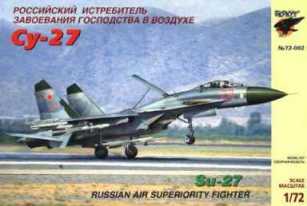 |
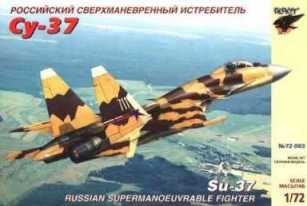 |
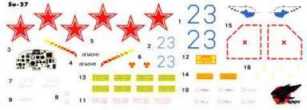 |
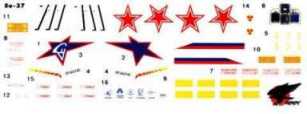 |
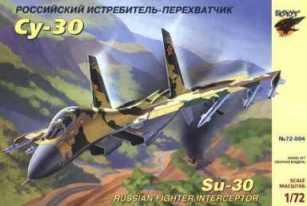 |
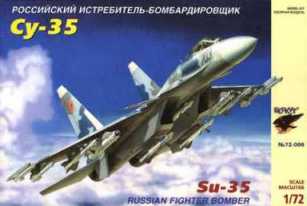 |
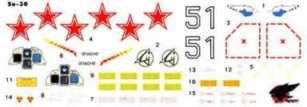 |
 |
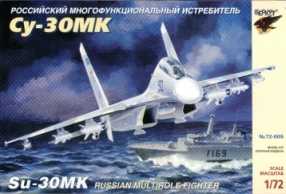 |
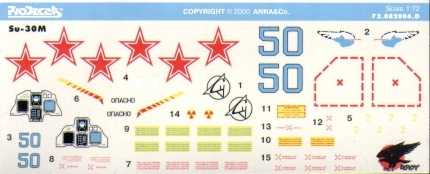 |
General
These are the Nakotne kits re-packaged with striking box art and new decals. I don't have any of these kits to hand, but from what I am told, they are no different to the original kits and therefore the same comments apply.
I have also seen some Su-27 kits advertised under an 'Eagle' label - As 'Berkut' means 'Golden Eagle' in Russian, I assume that these are yet another incarnation of the of the original Encore kits.
![]()
| Manufacturer :- | Hasegawa (Kit No 3400) |
| Scale :- | 1:72 |
| Variant :- | Su-27 Flanker-B |

Decals
Markings for just one aircraft - our old friend ‘Blue 388’, the Sukhoi OKB demonstrator. The sheet is up to Hasegawas usual high standards and is printed in matt. As well as the side number, the sheet contains six red stars, two stylised ‘CY’ logos, decals for the side consoles and instrument panel, a host of stencil data and Viktor Pugachevs name in Cyrillic script.
Accuracy/Construction
Span is just 2mm too great whilst length is absolutely spot on. The nosecone is about 1mm too great in diameter which alters the appearance of the front end and makes the whole nose seem too fat . In profile the spine is good and the dorsal airbrake and tailcone are correct. The wings are moulded integrally with the upper and lower fuselage halves which eliminates the joint line found on the other kits.
The horizontal tailplanes are the correct shape and size and are in the correct position relative to the wing trailing edge but it is in this area that the kit’s major flaw lies.
The rear fuselage is 5 to 8mm too wide (depending on whose drawings you consult) which puts the engine exhausts and vertical fins too far apart . It also makes the tailplane span too great. The exhaust nozzles are good with neat detail and an etched steel afterburner flame holder being trapped between the nozzle and jetpipe.
The intakes are of the correct depth with sharp lips and boxed-in wheel wells. An etched steel mesh grille is provided which can be bent into the deployed position before being attached to the upper ramp. Inserts for the engine compressor faces are supplied.
The fins are absolutely spot on in shape and size and are complete with tailplane actuator covers and hollowed out leading edge intakes - although Hasegawa, along with all the other kit manufacturers, haven’t spotted that the starboard fin intake is much smaller than the port one.
The ventral fins are good in depth but are about 2.5mm too long.
Cockpit detail is good with a bathtub, a rear bulkhead, instrument panel and excellent control column. Etched steel panels are supplied for the side consoles and instrument panel in place of the decals should you wish to use them. A very good etched HUD is supplied as are three rear view mirrors for the canopy arch. The seat is cast in white metal and is a reasonable facsimile of a K-36DM ejection seat, although it is a little on the small side. Detail parts consist of a nose probe with correct vortex generators, all the air-data probes, RWR aerials and even an actuating ram for the canopy. An etched steel firing handle is on the fret but it is too small even for Hasegawa’s undersized seat.
The canopy is the correct size and shape and is crisply moulded in Hasegawa’s usual style, but because they have managed to correctly capture the bubble shape of the canopy, there is a mould seam down the canopy and windscreen centreline which needs to be removed - the price of accuracy ! The windscreen itself is correct and has the correct-size IRST ball moulded integrally. The decking behind the seat is a separate item and is correctly shown as being attached to the canopy - the only kit to do this.
The undercarriage on this kit is cast in white metal and is a gem. The mainlegs are crisply cast with all the actuator detail correctly done - including the locking pins which fit into the bulges on the engine trunks. The main wheels are plastic with two halves to each wheel and are the correct diameter with good hub detail. The noseleg, wheel and anti-FOD guard are superbly cast in one piece with separately cast sway braces and steering ram cylinders. The landing lights are moulded in clear plastic. The undercarriage doors are all correct in shape and all have separate actuating rams.
A full armament fit is supplied consisting of four short-burn AA-10 Alamo A/B missiles, two long-burn Alamo-C’s and two AA-11 Archers. The Alamo A & B are OK for length and shape but the Alamo-C’s are slightly too long and lack the fattened rear fuselage. The AA-11’s are good but would benefit from having the leading edges of the tail fins cut back to an angled shape.
The weapons pylons are absolutely spot on and have formed the basis for replacements on all my 1:72 scale Flanker kits.
General
I am in two minds about this kit. It is superbly moulded in Hasegawas usual style with crisp engraved surface detail and it fits together very well. It is a so-called ‘Hi-Tech’ kit with etched-steel and white-metal parts, although I have to say that the white-metal undercarriage could probably have been done equally well in plastic. The etched parts are good and are usefully employed where the medium is at its best - the HUD, canopy mirrors, intake mesh and afterburner ring.
The instrument panels are just as good on the decal sheet whilst the rest of the etched fret is just about useless. There are grilles for the intake sides and a few grilles for the forward fuselage but no provision has been made to locate them in any recesses - they just stand proud of the surface and seem to have been added as an afterthought. The parts that could have been supplied as etchings, such as the various aerials on the fins, the ‘Odd-Rods’ IFF aerials and the gas exhaust slots on the cannon are not included.
Although it is the most expensive of all the Flanker kits, I used to
consider this the most accurate of the available Flanker kits until a
colleague
pointed out the error in the rear fuselage that I hadn’t noticed. On
its
own, this error is not readily apparent, but placed next to other
Flankers
or over a drawing, it stands out like a sore thumb and I can’t look at
a Hasegawa Flanker now without my eyes being drawn to the fault.
Combined
with its hefty price tag and the slight inaccuracy around the nose
contours
this kit has fallen from its pedestal in my eyes.
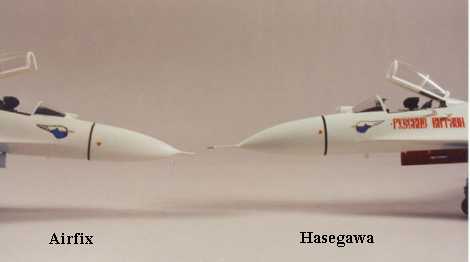 |
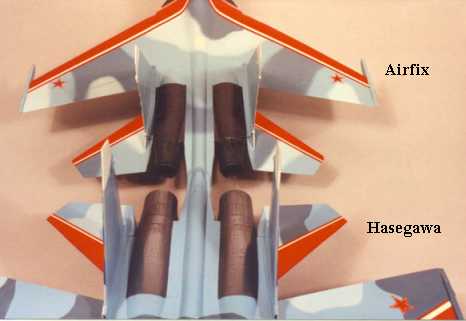 |
|
|
|
![]()
| Manufacturer :- | Hasegawa (Kit No SP70:3400) |
| Scale :- | 1:72 |
| Variant :- | Su-27 Flanker ‘Russian Knights’ |
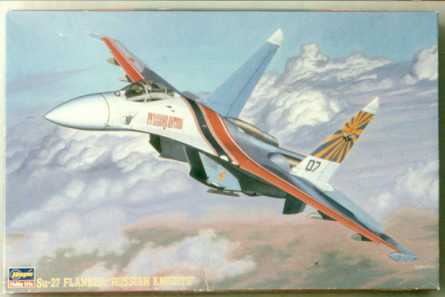
Decals
The decal sheet comprises the red/white/blue wing/fuselage chevron,
the tailplane chevrons, the fin ‘sunburst’ VVS flag, the ‘Russkiye
Vityazi’
logo in Cyrillic script, the Sukhoi ‘winged archer’ and ‘CY’ logos and
the ‘Proskurovski’ Kubinka badge for the intakes. Blue numerals are
supplied
to make any of the teams single seaters.
Accuracy/Construction
This is the same as the previous kit re-released with markings for the ‘Russian Knights’ aerobatic display team based at Kubinka near Moscow. The same comments apply to this kit.
General
Along with the new decal sheet came a hike in price which made an already expensive kit even more so, but until the recent release of a ‘Russian Knights’ decal sheet from the Russian firm of Travers, this was the only way to model a team aircraft.
![]()
| Manufacturer :- | Hasegawa (Kit No SP123:3400) |
| Scale :- | 1:72 |
| Variant :- | Su-27 Flanker ‘Test Pilots’ |
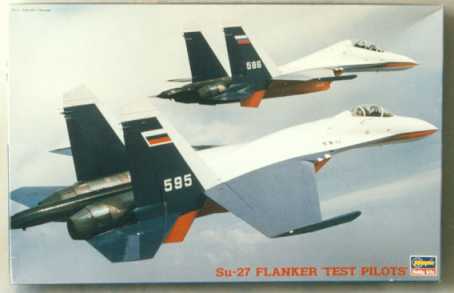
Decals
As well as the ‘standard’ decal sheet, this kit features a large sheet containing the dark blue areas on the wings, tailplanes and fins, the black area around the jetpipes, the red undersides on the tailplane and the red/blue stripes on the nose. The ‘Test Pilots’ logo and LII badge are included as are the tail numbers for just one single-seater - 595. The rest of the red areas on the underside and lower wing will have to be painted on - Hasegawa quote Gunze Sangyo/Mr Color matches for this. Note that the sponsors logo - ‘Jupiter Insurance’ is the later, correctly spelt version, if you want to model the earlier spelling of ‘Insuranse’ you will have to alter the decals.
General
This is Hasegawas third incarnation of this kit which represents the now familiar ‘Test Pilots’ display aircraft as flown by Anatoly Kvotchur. Although they have supplied most of the decals, I feel that most modellers would prefer to airbrush the large blue/red areas leaving the decal sheet to just supply the codes and badges - as well as possibly the nose striping. As it is, the modeller still has to paint the undersides, so he might just as well have done the lot.
One thing that Hasegawa do not mention is that aircraft 595 is a Su-27P and does not have the IRST ball nor the RWR antenna on the intakes (check the box art). The RWR antenna can be just left off and the mounting holes filled but the IRST ball will require some careful surgery to remove it from the windscreen.
With this third release, Hasegawa have again increased the price to beyond that of the 1:48 scale Flanker from Minicraft. With the ‘Test Pilots’ decals being available from other sources, they have certainly priced themselves out of the market as far as I am concerned.
![]()
| Manufacturer :- | Hasegawa (Kit No 00095) |
| Scale :- | 1:72 |
| Variant :- | Su-30KI |
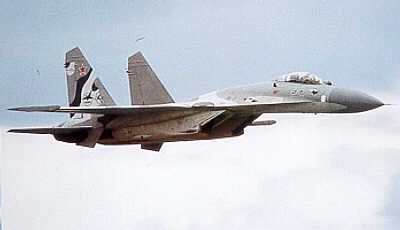
This kit contains a decal sheet for the black & white camouflaged demonstrator - complete with 'Su-30MKI' nose logos and 'Su-27 Family' markings.
General
Yet another re-release of the standard Su-27 kit with a new instruction sheet and decals, this time in the guise of the Su-30MKI. This was a machine destined for the Indonesian market and incorporated systems from the two-seat Su-30MK into a single seat airframe - hence the unusual designation. When the Indonesian deal fell through, Sukhoi decided to use the aircraft as a systems and cockpit demonstrator.
The Su-30KI differs from a 'standard' Su-27 in having a refuelling probe on the left side of the windscreen, but the IRST ball has not been moved to accomodate it, so it does not retract fully, but stands slightly proud of the airframe. The windscreen also appears to be gold tinted in the photographs I have seen - neither this, nor the IFR probe is included in this new kit - just the decals.
I must confess that I have not actually purchased this kit - I had made my Su-30KI before Hasegawa released their kit, but I have had a peek inside the box. It does provide a source of the unusual decals - albeit an expensive one !
![]()
| Manufacturer :- | Airfix (Kit No 05025) |
| Scale :- | 1:72 |
| Variant :- | Su-27 Flanker-B |

Decals
Markings for two aircraft - ‘Red 05’ from a unit on the Kola peninsula and ‘Blue 57’ based on Sakhalin Island, which makes a welcome change from the demo aircraft 388. Six red stars are included as are two ‘winged archer’ logos and a reasonable amount of stencilling. The ‘Red 05’ on some of my samples is off register, but other than that, the decal sheet is nicely printed in matt.
Accuracy/Construction
The kit contains 82 parts moulded in medium grey glossy plastic with engraved panel detail plus a clear sprue with a canopy and a windscreen that has a slightly undersized IRST ball moulded integrally. Span is spot on whilst length is just 3mm too short. The wings are good with correct sweep and chord although the integrally moulded wingtip pylons need replacing. The vertical fins are correct in shape and size as are the horizontal stabilisers and ventral fins. In profile the shape is good with a curved spine and slim radome that captures well the look of the real thing.
In all respects this is, in my opinion, the most accurate kit of a Sukhoi Su-27 Flanker currently available. Comparing it with all my reference drawings shows it to be just about perfect in overall shape and dimensions. The intakes are of the correct depth and shape but where they join the engine trunks there is just a flat face where the engine compressor front should be. An attempt has been made to model the mesh intake debris guard but this is represented by a flat piece of plastic with the mesh engraved on it that is totally unrealistic.
The exhausts are good and capture the double-walled appearance adequately. Cockpit detail is sparse, consisting of a bathtub with minimal raised panel detail, an instrument panel with better detail, a three-part representation of a K-36DM ejection seat and a very good control column. The coaming behind the seat is moulded integrally with the fuselage and the dorsal airbrake is correctly sized and openable. The clear canopy and windscreen are rather on the thick side and are just a shade too small - although this is better than being too big which is a fault on some of the other kits.
Each main undercarriage comprises a main leg with a two-part wheel. The leg is adequately detailed, but lacks the rear actuating arm and the distinctive locking pin. The moulded axle is far too short and makes for a very small area on which to attach the wheel. The wheels themselves are correctly sized with good hub detail.
The nosegear consists of an upper leg complete with sway braces, a rear actuating arm, separate, opaque, landing lights and a nosewheel moulded integrally with the front fork and debris guard and it is in this area that the kit falls down. The size and shape of the whole nosegear is absolutely correct but in order to cater for the different mudguard shapes between the Airfix single-seater and the Heller two-seater, the fork/wheel/guard has been moulded as a separate item from the leg with just a crude butt-join between the two parts. Cemented together with super-glue, I haven’t yet had any problems on my Flankers, but the design results in a weak joint that is difficult to line up correctly and cement in place. The problem could have been avoided by either moulding the whole assembly in one piece or at least making a more positive joint between the two components. The actuating rods that connect the pivoting debris guard to the leg are not provided. The undercarriage doors ae good with correct shapes and internal detail but they lack the actuating rams. The nosedoor has the pneumatic reservoir bottle moulded integrally.
Armament fit comprises four AA-10 Alamo A/B and two Alamo-C missiles which are just about right in size and shape plus four AA-11 Archer short-range IR missiles. The Alamo’s have two of their four forward fins moulded separately and capture the inverse taper correctly and the shorter Alamo’s have slightly different shaped noses in an attempt to represent the IR and Radar equipped versions. Whilst the armament is OK, the associated weapons pylons are not. Airfix acknowledge that the pylons are not all the same and supply different styles for the various stations but they are simplified and those on the wingtips are decidedly the wrong shape and are seriously undersized.
General
Whilst this is in my opinion the most accurate Flanker in 1:72 scale, it is also the worst kit in terms of fit, flash and sink marks. The plastic is hard and brittle and suffers from mould flaws - particularly on the underside of the port wingtip where the plastic is so thin, there is a slight hole in it. Most of the components fit badly, especially the nosecone, the probe at its tip and the intakes to the engine trunks. Once sanded and filled, it does make up into a very accurate replica of a Flanker that has formed the basis of most of my collection. It also has the added bonus of being reasonably cheap and was, until recently, readily available.
![]()
| Manufacturer :- | Heller (Kit No 80371) |
| Scale :- | 1:72 |
| Variant :- | Su-27UB Flanker-C |
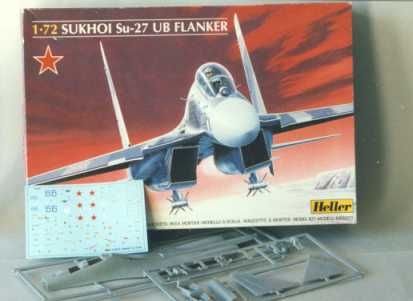
Decals
Markings are provided or just one aircraft - ‘Blue 66’ of an unidentified unit. The sheet includes nose and tail numbers, six red stars, two ‘winged archer’ logos and a host of stencil data - including the white dielectric aerials on the wing leading edges and spine. The sheet is well printed in matt.
Accuracy/Construction
This is exactly the same kit as the Airfix offering with new sprues containing a new upper fuselage, new taller fins, a larger dorsal airbrake, a two-seat cockpit bathtub, an extra ejection seat, instrument panel, pilot and control column plus a completely different nosewheel/fork/debris guard moulding which is absolutely correct for the two-seater but does suffer from the same weak joint as its Airfix counterpart.
A clear sprue contains a new two-seat canopy and the same windscreen as in the Airfix kit.
The same comments made about the Airfix kit regarding accuracy and fit of parts applies to this version but it does make up into a good replica of the two-seat combat capable trainer version of the Flanker.
General
Until the arrival of the Nakotne two-seater, this was the best and only Su-27UB kit available in this scale and it has not been superceded by the newcomer. The two-seater is gaining in importance in the Sukhoi camp with more capable developments such as the Su-30, Su-30MK and the new canard and thrust vectoring equipped version ordered by the Indian AF, the Su-30MKI, so this kit can form the basis of quite a few new conversions. Unfortunately, it is now very difficult to obtain, having been deleted from Heller's catalogue.
![]()
| Manufacturer :- | Heller (Kit No 80550) |
| Scale :- | 1:72 |
| Variant :- | Su-27UB Flanker-C ‘Russian Knights’ |
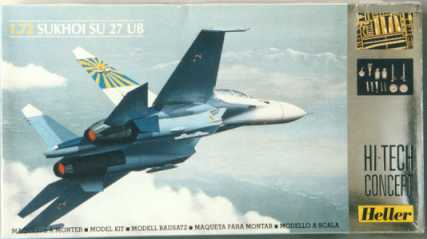
Decals
A large new decal sheet contains the wing and tailplane leading-edge chevrons, the fin ‘sunburst’ VVS flags, the Sukhoi ‘winged archer’ logos, a ‘CY’ and Kubinka logo for the intakes, ‘Russkiye Vityazi’ script and numerals for just one of the two seaters, number 18.
The rest of the sheet is the same as the ‘standard’ kit but adds bort numbers for ‘Black 61’, a Su-27UB based at Chojna, Poland.
Accuracy/Construction
The kit is exactly the same kit reviewed previously with the addition of a new decal sheet and the inclusion of a bag of white-metal parts and a fret of etched brass thus giving it the ‘Hi-Tech’ label.
The white-metal parts consist of main and nosewheel legs, wheels and ejection seats that are exact copies of the plastic components with the addition of brake pipe detail on the main legs. New are parts for the cockpit side walls (four parts shown on the assembly diagram, only two supplied in the kit) and a mainleg rear retraction arm that is absent on the plastic item. The etched brass sheet contains cockpit console detail, instrument panels (shaped differently from the plastic items they are supposed to be attached to), seat harness, seat firing handle (too small), cockpit sill detail and rear view mirrors, rudder pedals, a simplified HUD, a few aerials, a single Odd Rods IFF antenna (there should be two) and four angle-of-attack sensors.
General
The inclusion of a new decal sheet for the Russian Knights is very welcome, but the so-called Hi-Tech parts add very little to the basic kit, except to the price. The white metal parts are hardly better than the plastic items, and while some of the etched brass items are useful, they have been added as an afterthought and do little to improve the kit. Indeed, the etched brass panels do not even fit their plastic mounts and there is no mention of the fact that detail needs to be removed from the plastic instrument panels to allow the etched brass parts to be cemented flush on the panel.
![]()
| Manufacturer :- | Italeri (Kit No 059) |
| Scale :- | 1:72 |
| Variant :- | Su-34/Su-32FN |
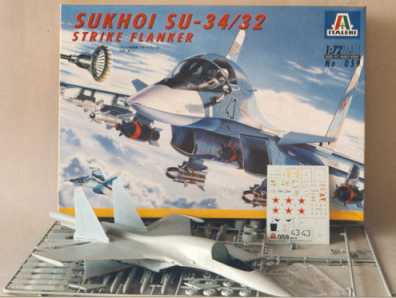
Decals
A well printed gloss decal sheet containing six red stars, two ‘winged archer’ logos, a host of stencil data and numerals to make two machines - ‘Blue 43’ and outline-only ‘White 45’, the first two pre-production machines. Included on the sheet is the 1995 Paris Salon buzz number that the aircraft wore - ‘White 349’
Accuracy/Construction
With 115 parts moulded in light grey plastic with engraved panel detail and a clear sprue containing the fixed canopy, HUD and taxy light lenses plus clear lenses for the IR missiles, this is the first kit on the market of the side-by-side two seat strike variant of the versatile Flanker designed to replace the Su-24 Fencer in Russian service.
Fortunately it is a good one with well fitting parts and, except for one or two minor errors, it is accurate. Wingspan is almost spot on with chord and shape being perfect.
The cockpit is simplified but adequate given the fixed canopy and includes a combined floor/rear bulkhead with consoles, two control columns, two basic K-36DM ejection seats and an instrument panel. The panel and consoles have raised detail but the main panel should have four large multi-function TV displays, not the dials depicted in the kit. Fuselage shape is good in plan and profile although the rear spine curves a little too sharply where it joins the enlarged tailboom. The boom itself is a little too long according to published dimensions - remove 6mm from the end of the boom before cementing the endcap in place.
Tailplanes are correct except for the angled tips which are too curved in plan - a quick wipe with a sanding block soon straightens them.
Engine intakes are good with correct depth and lower intake slot although no attempt has been made to respresent a compressor face where the intakes meet the engine trunks. Exhaust nozzles are simplified but do have an insert to represent the afterburner ring.
The vertical fins are completely incorrect, being the taller versions found on the Su-27UB and the prototype Su-34, the Su-27IB. The production Su-34 has reverted to the smaller ‘standard’ single-seat fins and discarded the ventral fins. Either cut down the kit items or replace them from a single-seater kit.
The forward fuselage and nose shape is correct as are the canards and their mountings but later photographs of the Su-34 show a larger straight-edged fillet tacked onto the LERX just forward of the canards. This can be added from thin plastic card.
The undercarriage is a gem with the nosegear being made up from a leg, sway braces, two landing lights with clear lenses, twin wheels and an anti-FOD mudguard. Note that the mudguard is different in shape between aircraft 43 and 45, so check your references and alter accordingly. The tandem wheel maingear is simplified but accurate, consisting of a one-piece main leg, separate scissor link, two part twin wheels and - at last - that locking pin. All the undercarriage doors are accurate in shape and are complete with actuating rams.
Armament fit is comprehensive and accurate, comprising three KAB-1500L Laser Guided Bombs, two Ch-31 (AS-17) Anti-Radar missiles, two Ch-29L (AS-14) AGM’s, two R-77 (AA-12) AAM’s and two R-73 (AA-11) Archers plus all their associated pylons. The fins of the LGB’s are incorrect and the unusual lattice fins on the R-77’s really need to be in etched brass to do them justice, but overall the weapons are very well executed.
Final details include a retracted or extended in-flight refuelling probe and all the various aerials and sensors on the airframe.
General
As the first and so far, only, kit of the ‘Strike Flanker’, Italeri's kit can be made up into an accurate replica of this important addition to Russia armoury, given the few alterations mentioned here.
![]()
| Manufacturer :- | Revell (Kit No 04304) |
| Scale :- | 1:72 |
| Variant :- | Su-34/Su-32FN |
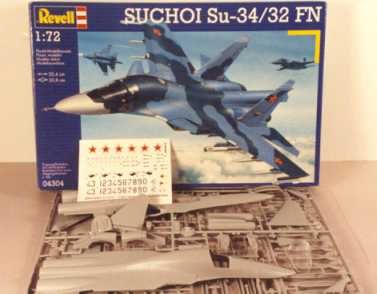
Decals
Six red stars, no less than five ‘winged archer’ logos, two ‘CY’ logos, numerals for ‘Blue 43’ plus numbers 0 - 9 in white outlined blue and minimal stencil data that, usefully, includes the designators of the various weapons pylons - APU-470, AKU-170 etc. The decal sheet is well printed in Revell Germany’s usual style.
Accuracy/Construction
This is the Italeri kit re-issued by Revell Germany in a new box with a new decal sheet, so the same comments apply here.
General
The decal sheet is not as good as that in the Italeri kit and Revells kit is, at least in the UK, more expensive, but it does have four close-up colour photographs of the real thing on the side of the box, which is useful.
![]()
| Manufacturer :- | YuMTK (Kit No ?) |
| Scale :- | 1:72 |
| Variant :- | Su-34 |
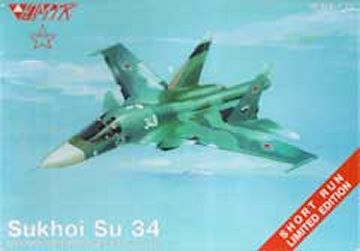 |
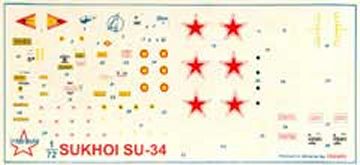 |
General
I do not have this kit - only a scan from Tushino Aviapress showing the boxtop and decal sheet, so I cannot comment on its accuracy nor the quality of the decals.
It is included here for completeness, but given the availability and general soundness of the Italeri/Revell Su-34 kits, I would imagine it would not be a best seller - especially in the west.
Thanks to Efraim Hernandez for reminding me about this kit...
![]()
| Manufacturer :- | Zvezda |
| Scale :- | 1:72 |
| Variant :- | Su-27, Su-33, Su-35 |
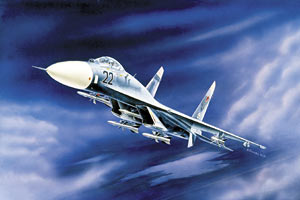 |
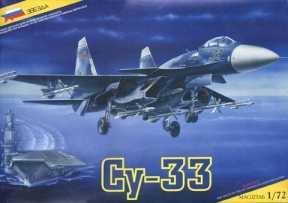 |
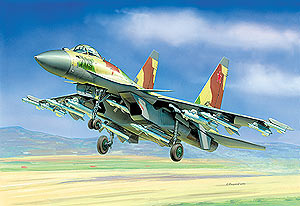 |
|
|
|
|
More re-boxings, this time of the Italeri kits (Su-33)
and
the Nakotne/Encore/Berkut (Su-27 & Su-35).
The Su-35 incorporates taller, Su-35-style fins, although they are
still not 100% accurate.
![]()
| Manufacturer :- | Revell (Kit No 04319) |
| Scale :- | 1:72 |
| Variant :- | Su-27 Flanker-B |
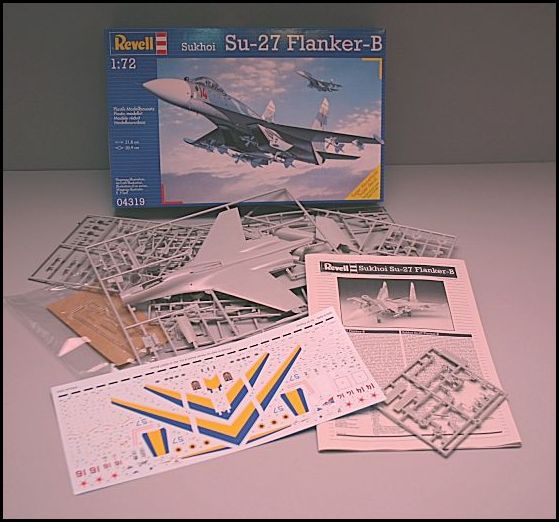
Decals
A superb decal sheet containing markings for 3 Flankers - 'Red 14' of the 1st Sqn 941 IAP-PVO based at Kilp-Yavr, Kola Peninsular Sprin 2000, 'Red 16' from the same Sqn but dated Autumn 1999. These two markings are remarkably like those supplied by Linden Hill on their magnificent 'Flankers on Patrol' decal sheet! The final option is for 'Blue 57' - one of the Ukrainian AF demonstration machine that visited RIAT Fairdford in 1996. This time the decals are similar - but not the same as - those supplied on the Cutting Edge sheet - except that Revell depict a/c number 57 whereas Cutting Edge depict a/c number 48. As well as the three choices of subject, there is a mass of stencil data as well as decals for the instrument panels chaff/flare dispensers and white dielectric panels. It even includes stencil data for the weapons pylons and missiles! The decals sheet alone is almost worth the price of this kit!!
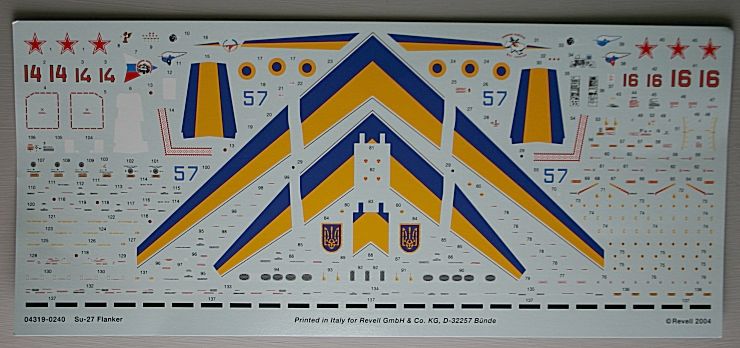
General
The bad news is that this is not a new kit. It is the Hasegawa kit re-boxed by Revell. The good news is that it sells (at least in the UK) for half the price of the Hasegawa original - which is a bonus - but it also suffers from the shape/accuracy problems highlighted in my review of the Hasegawa kit.
As well as a new box and decal sheet, this kit dispenses with the white-metal K-36D ejection sheet and undercarriage and etched-steel fret in the Hasegawa kit.
Revell have included a new sprue (sprue F) giving the same parts in injection-moulded plastic.
This is no bad thing - the main undercarriage legs and nosewheel/leg are just as good in plastic as white-metal. The kit-supplied K-36D seat - whether in white-metal or plastic - needed replacing with a NeOmega resin seat anyway. The only negative aspect is the replacement of the HUD and intake mesh grille from the etched fret. The Revell replacement parts are not really usable - the intake grill is just a flat piece of plastic with a raised mesh pattern and the HUD is also solid with the framing depicted as raised lines. In fact, Revell's instruction sheet does not show this HUD being attached at all - in one drawing in the construction sequence it is absent, a few pages further on it is present!!! The intake grille is meant to be folded up to depict the grille as raised - but all it does is blank off the intake. Better to leave it flat against the bottom of the intake - where it sits normally when the engines are not running.
Revell's A-4 sized instruction sheet - which uses Hasegawa's drawings suitably modified - is a almost a booklet !!! It starts with a history of the Flanker - in German & English - a page of 'read before you start' instructions in no less than 21 languages, a page of construction symbols - with explanations in 18 languages, a page of paint colours - using mixes from Revell's paint range - in 18 languages, a page of the sprue layout, seven pages of the actual construction sequence and five pages showing the decal placement. They also include a separate sheet - in 21 languages - called 'Security-Text!' that gives warnings and safety rules about such things as washing hands after 'carrying out activity' and 'read the instructions before use.....' !!
This is political correctness gone mad and reflects the litiginous nature of the world today!
Compare this to Hasegawa's A5 sheet that manages to convey all the above in just 8 pages.
There is glaring error in Revell's instructions - on the camouflage drawings at the back. This shows the radome and dielectric panels flagged as being painted in the colour 'I' - looking at the colour legend on page 3 - letter I is not listed - the letter G is used instead - (this is obviously a misprint - the letter G is used twice).
Revell also persist in using these mixes of their own colours to produce a match - the Flankers Medium Blue-Grey is meant to mixed from 75% Matt 55, 20% matt 5 and 5% matt 56 - why can't they just give an FS number like everyone else?? The camouflage pattern drawings are also difficult to interpret - because of them being printed in B&W, you can't very well differentiate between the 'steel' and 'white' areas.
In conclusion, this is a welcome release by Revell of the Hasegawa kit. Whilst not the most accurate Flanker - IMHO - it does at least make the old Hasegawa kit readily avaiable at a much reduced price.
![]()
| Manufacturer :- | Airfix (Kit No 05025) |
| Scale :- | 1:72 |
| Variant :- | Su-27 Flanker-B |
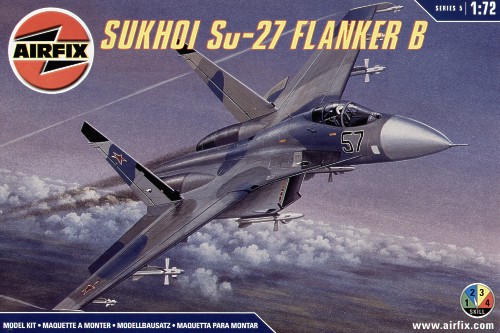
General
This is the old Airfix kit re-boxed !! The box art is not even as good as the original - which isn't saying much - and looks about as much like a Flanker as I look like Brad Pitt!!! - all the elements are there, but not necessarily in the right proportions.
It also contains the same tired old decal sheet ! Airfix have made no attempt to update the kit - at the very least a new decal sheet would have breathed a new lease of life into this kit - which, in my opinion, best captures the look of the real thing.
They could have given us some Indonesian markings, Vietnamese, Chinese etc, but no, the bean counters have opted for just a new box lid - and a poor one at that.
Come on Airfix - keep up with the opposition !!!
![]()
| Manufacturer :- | Alanger |
| Scale :- | 1:72 |
| Variant :- | Su-27 and Su-30 |
 |
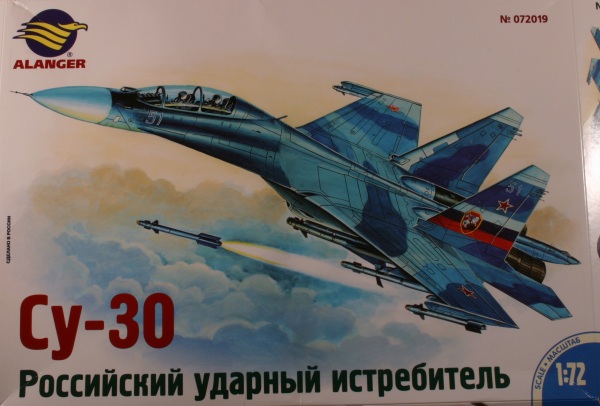 |
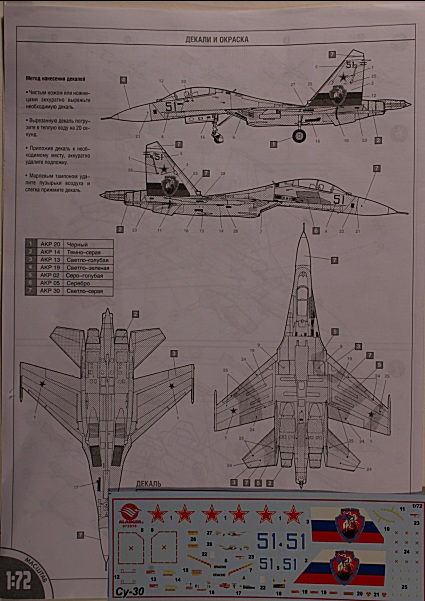
| Manufacturer :- | Gerald Elliott |
| Scale :- | 1:72 |
| Variant :- | Su-27 'Flanker' |
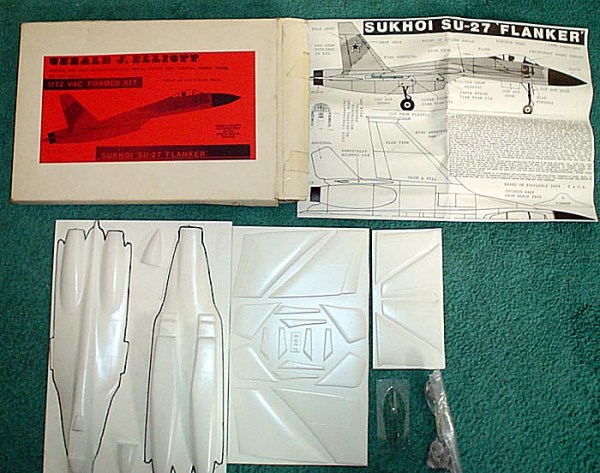 |
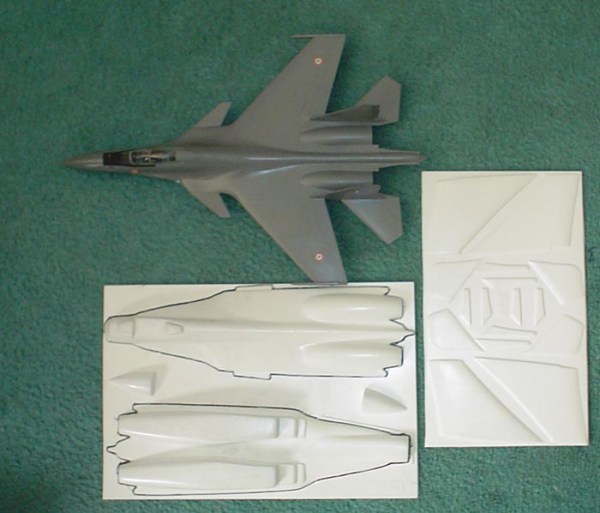 |
| Manufacturer :- | Academy (Kit No 2131) |
| Scale :- | 1:48 |
| Variant :- | Su-27 Flanker-B |
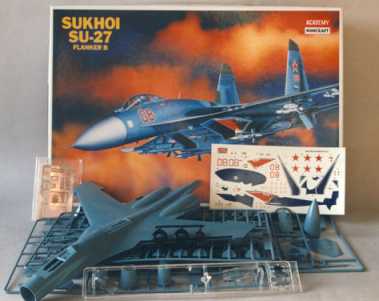
Decals
Academy include just once choice on the decal sheet - but what a subject ! The markings are for ‘Red 08’, an operational machine from the training base at Lipetsk. As well as the ‘normal’ sharksmouth sported by aircraft from this unit, aircraft 08 has a complete shark painted down the port side of the fuselage and fin and this is included on the decal sheet. Also on the sheet are six red stars, the nose and tail numbers, two ‘winged archer’ logos and some stencilling. The decal sheet is printed in gloss and is very thin but opaque. The decals go on beautifully and adhere to the model perfectly without the use of setting agents, giving a ‘painted on’ look to the markings.
Accuracy/Construction
Comprising 154 parts moulded in blue-grey plastic plus a clear sprue containing the canopy, windscreen, lenses for the IR missile seeker heads and a three-part HUD - but no lenses for the landing/taxy lights on the nosewheel. Panel detail is very well executed, being finely engraved and suitably restrained. A photo-etched fret is included and contains the anti-FOD mesh screens for the intakes, parts for the undercarriage doors, nosewheel well and rear view mirrors for the canopy arch - but not for the prominent HUD - this is on the clear sprue and is the worse for it.
Span is absolutely correct and the overall wing shape is very good with separate flaps and slats. The length is 16mm too short - which is exactly the length of the nose probe. The quoted length of a Su-27 WITHOUT NOSE PROBE is 456.9mm in 1:48 scale, but Academy’s kit is that length exactly INCLUDING the probe - an error that crops up in a lot of the models reviewed here. Nonetheless, the overall shape of the fuselage is correct and it captures the curved-down look very well. The dorsal airbrake is separate with its own actauating ram.
When it was first released I raved about the overall accuracy of this kit, but on more sober reflection, everytime I look at my model the more I think that the nose it slightly too big and bulbous - not by a lot, but just enough to be noticeable.
The intakes are correct and include compressor faces and the aforementioned anti-FOD screens. There is one slight error in the kit - the lower fuselage where it meets the wheel well has no cutout to accomodate a retracted wheel ! It is a simple job to correct. The cockpit area really lets the kit down. Although it is well moulded with a bathtub, instrument panel, control column and a three-part ejection seat, it is far too shallow and the seat is totally inaccurate. The whole cockpit assembly is best replaced by one of the resin sets now on the market - NeOmega would be my choice..
The tailplanes are correctly shaped and feature a separate actuator cover that fits inside the housing at the base of the fin as on the real thing. The vertical fins are accurate with separate rudders, although their intakes are both the same size. The ventral fins are correct in size and shape.
The winscreen and canopy are thin and beautifully clear, but in order to capture the bubble shape, Academy have had to mould them with a seam line down the apex which should be carefully removed. The IRST ball is moulded integrally in the centre of the windscreen which makes conversion more difficult. The rear cover that rises with the canopy is moulded with the fuselage and will need to be removed if the canopy is to be displayed open.
The undercarriage is a tribute to the toolmakers art and makes up into an accurate replica of the real thing. The nosegear is made up from no less than thirteen parts with a completely separate anti-FOD guard, whilst the mainlegs are just one-piece with a separate small actuating ram. The mainlegs correctly depict the rear retraction arm and are finished off with the addition of a separte locking pin. The nose and mainwheels have separate plastic hubs and rubber tyres which, when scrubbed down to take off the sheen, look very good indeed. The undercarriage doors are all accuarate and feature separate actuating rams, etched steel detail on the main doors and a separate pneumatic reservoir bottle for the nosedoor.
The armament fit comprises eight AA-10 Alamo missiles - both long and short range, four AA-11 Archers and two AA-8 Aphids. The short-burn Alamo A/B’s are just about the correct length, but the Alamo C’s are a bit on the long side and are too narrow at their rear. Two of the four forward fins are moulded separately but the fins on all the missiles are a little on the thick side and would benefit from being thinned down.
There are also two missiles that look like smaller clones of AA-10 Alamos but I could find nothing in my references to match them. The AA-11 Archers are accurate and Academy supply two versions - IR and Radar Homing but I can only find reference to IR version.
The AA-8 Aphids are also accurate but they are not normally carried by the Flanker, being earlier generation missiles. The weapons pylons are accurate - except for the wingtip ones that are a litle on the long side.
General
As this is the only available kit of the Flanker in 1:48 scale it is a good job that it is basically accurate. It fits together beautifully and certainly captures the look of the Flanker - except maybe for that nose !
For a complete build article on this kit, check out my pages at Linden Hill
![]()
| Manufacturer :- | Academy |
| Scale :- | 1:48 |
| Variant :- | Su-27 Flanker-B ‘Russian Knights’ |
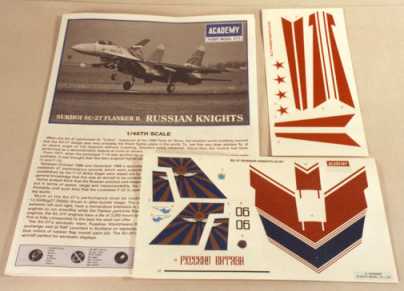
Decals
The sheet contains the red and blue chevrons for the fuselage spine and wing/tailplane leading edges, two ‘winged archer’ logos, a CY logo and Kubinka badge for the intakes, six red stars, the ‘Russiya Vityazi’ Cyrillic script, the fin VVS ‘sunburst’ emblem and numerals for aircraft 06. The sheet is well printed in gloss and, if the standard kit decals are anything to go by, they should adhere well. I would question the colours though - all my references show a much lighter blue on the fin badge and a yellow sunburst. Academy’s badge is dark blue and gold. The 06 numerals should also be bigger and in blue with a black outline.
Accuracy/Construction
As this is a re-release of the standard kit, the same comments apply.
General
This is a welcome re-issue designed to get the most out of Academy’s mould investment by having a new decal sheet for the popular Russian Knights aerobatic team. It is just a pity that the colours are wrong.
![]()
| Manufacturer :- | Academy |
| Scale :- | 1:48 |
| Variant :- | Su-27UB Flanker-C |

Decals
Decals are provided for just one option - ‘Red 66’ of an unidentified unit (there is a picture of a Su-27UB ‘Red 66’ on page 37 of WAP Aerospace Superprofile on the Flanker but without the ‘CY’ logos, so I don’t know if this is the same aircraft).
Accuracy/Construction
Ignore the abysmal box art - the artist has failed to depict the graceful hump-backed appearance of the two-seater and made his rendition something of a caricature - the kit mouldings do capture the shape perfectly.
This is the same kit as Academy’s single-seat Flanker with the necessary new mouldings to make the two-seat UCHEBNO BOEVOY - COMBAT TRAINER variant. These comprise a completely new upper fuselage moulding, new taller fins and rudders, a new cockpit bathtub, an extra seat, a new rear instrument panel and coaming and a second control column. The different style of mudguard on the noswheel of the Su-27-UB is not provided, so some modification to the kit item will be required. A new clear sprue contains the longer canopy and separate windscreen - again with the IRST ball integrally moulded. The canopy and windscreen both have a mould line down their apex which needs to be removed - they do capture the ‘pinched in’ shape correctly though.
The same armament fit provided in the single seater is included as
are
the etched metal parts.
Accuracy is the same as the single seater - spot on.
General
The only 1:48 scale two-seater on the market and fortunately it is a good one. The decal options could have been a little bit more adventurous and included a few more choices, but all in all this is an excellent kit that captures the look of the ‘Sparka’ to perfection and is great value for money.
![]()
| Manufacturer :- | Zhengdefu |
| Scale :- | 1:48 |
| Variant :- | Su-27, Su-27UB, Su-35 'Versatile' |
 |
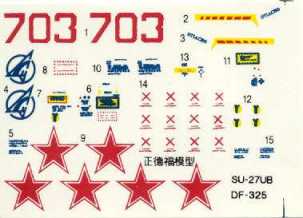 |
Decals
As shown in the photograph, the kit includes a poorly printed decal sheet with six red stars, 'CY' logos, totally incorrect bort numbers for 'red 703' and a few stencils.
General
These are the Academy kits produced in China by Zhengdefu. They have also apparently appeared under the Trumpeter label. They differ from the Academy originals in that the wings are separate from the fuselage and the panel detail is perhaps not so crisp. They are however incredibly cheap - at least here in the UK. As far as I know, Zhengdefu released both the Su-27 and the Su-27UB kits plus the one that I have - the Su-35. This is labeled as 'Versatile' - which I assume to be the best translation of the Russian word for 'Multi-Role' they could come up with. Although purporting to be a Su-35 'Super Flanker', it clearly isn't ! Zhengdefu have altered the upper fuselage moulding to include the canards - but the are just attached to the LERX and do not have the prominent mounting shoulders of the real thing. The fins have separate endcaps - and new pieces are included for the straight-tipped Su-35 fins, but they should be much taller than the Su-27 fins and they are not. Also not catered for are the twin nosewheels, offset IRST ball, refuelling probe and revised tailboom.
If you really want to make an accurate Su-35 - check out my conversion in 1:72 scale
![]()
| Manufacturer :- | Trumpeter |
| Scale :- | 1:48 |
| Variant :- | Su-27, Su-30MK, Su-37 |
 |
 |
|
|
|
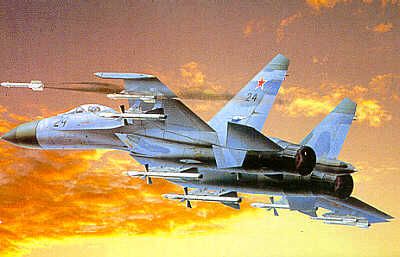 |
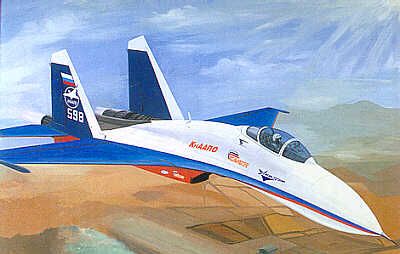 |
|
|
|
 |
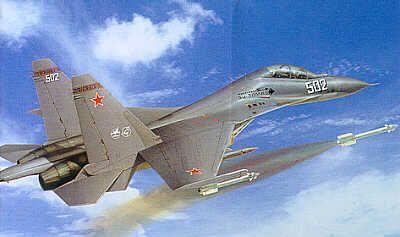 |
|
|
|
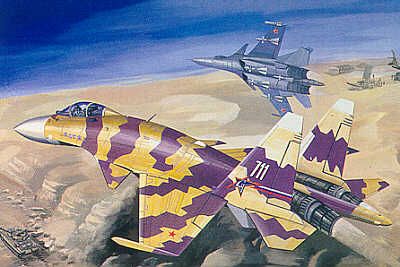
Russian Su-37 Super Flanker
General
These are the Academy kits produced in China by Trumpeter. Again, I do not have a sample to hand, so I cannot comment on whether Trumpeter have made the alterations necessary to produce accurate models (correct canards, big fins, twin nosewheels, offset IRST, IFR probe etc). A full kit review will be added when one becomes available.
from Tony Leger ...........
Just to add to what Ken posted I got the UB (Trumpeter #02201) and moulding similar to Italeri in smoothness and had a few deep ejector marks in the landing doors. The markings are identical to the Academy #66 bird. The Knights one referenced was purchased und the Trumpeter name, but on the box is labelled as MiniHobbyModels #0304. I'm still working on an Academy Flanker so I haven't made either, but the price was right.
- definite copy of the Academy kit
- The kit itself is reminescent of Italeri mouldings and isn't as crisp
as the Academy, however I feel it would still make
a
very nice kit.
- Instructions mixed between english/chinese. Content looks very
similar
to the Academy set just not done as nicely
- Decals are not the same as the Academy Knights kit. No gold...The
colours look right and overall paint scheme is for the newer colour
scheme
> for the Knights. Numbers are included to do any plane in the
series.
Register looked good.
- The cockpit needs to be replaced with either the Cutting Edge or
the Neomega one. Sidewalls a smooth and little detail on the instrument
panel
- I'd replace the burner cans with Cutting edge ones.
- The canopy has a small seam down it's center that should be able
to be sanded off.
- There isn't any photo-etch in the kit for the intakes
- Overall though it's Good value for the price paid ~$16 US vs $35
for the Academy. I'd buy another...actually just ordered the UB and
another
Knight's kit for some other variants to be made.
And......
If you mean the Trumpeter 1:48 scale Flanker, the following was sent to me by Gareth Phua.....
2 whole halves, top and bottom make up the entire a/c. Only the flaps and slats are seperate. I believe the tail rudders are seperate as are the horizontal stabs too
Oh, BTW, the mud guards are BEAUTIFULLY moulded. I believe the Trumpeter kit has it's origins in the Academy kit, which is obviously better than the ZDF from what I was told.
And.......... from Matt Brown :-
I don't know about the zengdufu kits, but here are my comments from my trumpter/mhm Su-27UB:
I saw this in my local hobby store for ¸11, so I decided I'd give it a shot.
Well, it's the Trumpeter/Zengdufu knock-off the Academy kit. I'd feel guilty if it was a copy of a Tamiya kit, maybe, but as Academy started off pirating themselves - oh well.
The kit composition is exactly the same as the Academy kit apart
from
the abscence of the photo-eteched parts and rubber tyres. The kit's
pirated
legacy is obvious from the directly-copied instructions, which make
reference
to these missing parts in several places - there's a picture of the
canopy
showing the placement of the photo-etched mirrors that has the
mirrors themselves crudely blanked out and a helpful diagram of the
assembly of the non-existant rubber tyred wheels.
The surface of the plastic has a very rough finished - it looks like
the model has been scale shot-blasted. The panel details are roughly
correct
- as if the basic shape was copied directly from the Academy plastic
and
the
details were scribed in with a pin afterward - this is very true
inside,
where the details (such as they are) literally look scratched into the
side consoles. Most of the other parts are somewhat sloppy, with lots
of
flash,
sink marks and the aforementioned rough plastic.
The decals ... well, from their general crispness and quality, I'd say that anything up to 15 minutes of deft crayon work was spent on them. I took one look, shuddered, and dropped them in the bin.
Overall, well, you get a lot of plastic for ¸11 and it does look a like ... sorta ... a UB Flanker when you're done. *If* you get done ...
And from Chris Bryant ..........
I got the Knights & SU 30 test pilots kits from Udisco in Montreal last week. They are very nice kits, totally different from the Zengdefu kits. The plastic is hard, there is no flash, the panel lines are fairly crisp, & the decals are quite good. I suppose that other than the lack of photo etched peices, they are no different from the Academy kits.
And from Marco Antonio........
Ken, just FYI, the Trumpeter Su-27s (and variants thereof) are *not*
the same as the Zhengdefu. They are based on the Academy kit, and have
added/corrected some stuff (The wings are not separated from the
fuselage,
for example, the canards
are nicely built and also like the wings are the same piece -though
I forget if they had separate positionable sections or not- and the
nose
contours have been modified so that now the cross-section isn't exactly
circular but rather oval
(actually, the upper part of the fuselage has a semicircular section,
while the lower has been flattened a bit - think of the F-16 or
something
similar). The decals are pretty decent too, and the quality of the kit
as a whole is very
good. About two months ago together with a friend who works at a hobby
store we matched some parts of the Trumpeter and Academy kits for
comparison.
Sadly, I don't remember any more details at the moment... Given that
the
Trumpeter kit
costs roughly half as much as the Academy ($25 vs $48 around here),
it's a good choice. My friend had previously seen the Zhengdefu kit
too,
and definitely he doesn't recommend it.
![]()
| Manufacturer :- | Hobbycraft |
| Scale :- | 1:48 |
| Variant :- | Su-27 Flanker-B |
No picture avaialable yet - but this appears to be a poor copy of the Academy kit - on a par with the Zhengdefu copy but not as good as the Trumpter copies.
From Ron Smith.........
It's the Zhengdefu mold but Hobbycraft actually paid attention to the molding process unlike Zhengdefu.
And from Matt Brown ..........
I've not seen it personally, but I do know it's a very poor copy of the Academy kit. One to avoid.
| Manufacturer :- | Trumpeter Models |
| Scale :- | 1:32 |
| Variant :- | Su-27 Flanker-B |
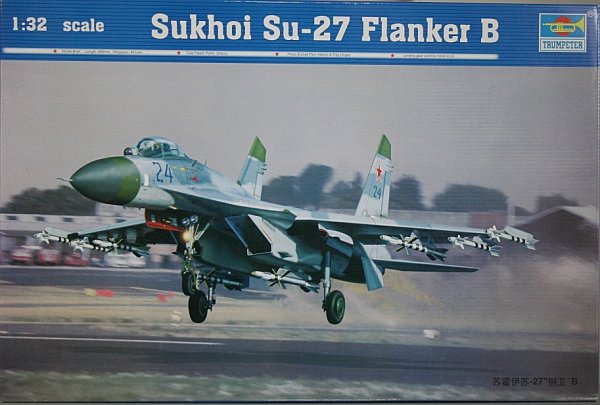 |
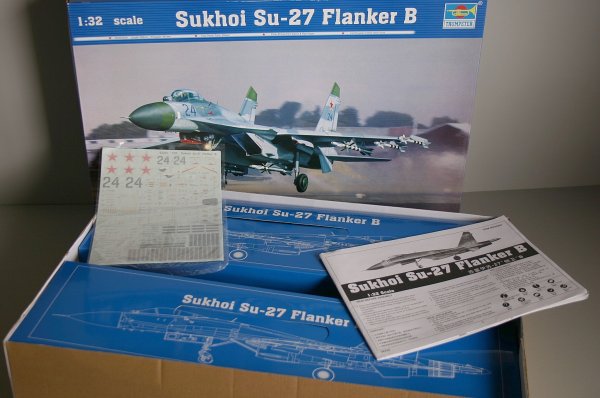 |
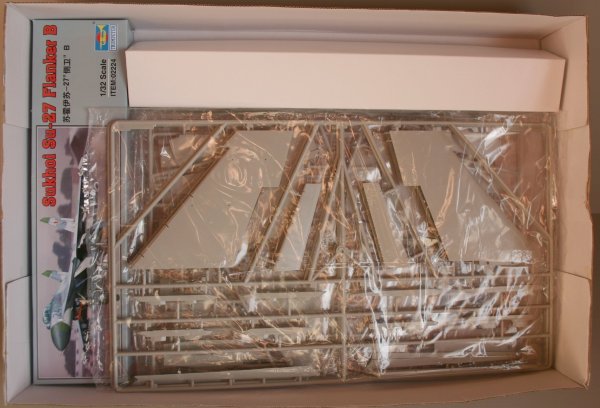 |
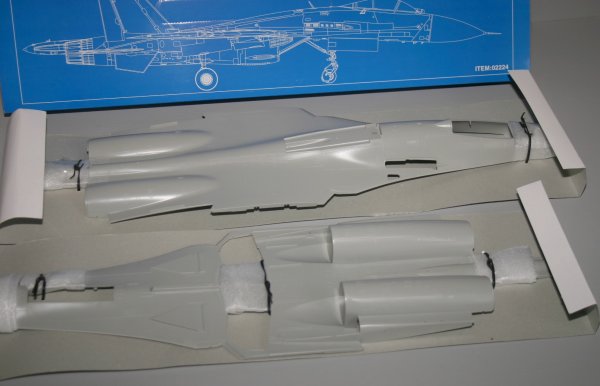 |
Decals
A well-printed decal sheet with markings for just one machine – a fairly uninspiring Su-27 Bort ‘Blue 24’ of the 582nd IAP, 4th Air Army, based at Chojna, Poland 1992. This is an early production example of the big Sukhoi – with green dielectric panels and radome.Trumpeter’s 1:32 scale kit of the big Flanker comes in a huge, stout cardboard box with a fine rendition of a standard squadron machine blasting off the runway, armed with a full load of air-to-air missiles – albeit training rounds - as denoted by their black bands.
This picture is repeated on the box ends, while
the box
sides show a four-view colour profile, drawings of the R-27 missiles
and a
short potted history, in English & Chinese, of the Flanker.
Inside the box the components are well packed to avoid
damage - the upper and lower fuselage halves being held by
plastic twists inside their own cardboard packaging.
Underneath the individually packaged fuselage
halves, the
rest of the sprues are sealed inside their own plastic bags, whilst the
clear sprue, canopy, windscreen, exhaust nozzles,
etched-steel fret, white metal undercarriage components and rubber
wheels are
packaged inside a separate cardboard box – with the box art repeated on
its
cover.
The windscreen and canopy are further protected by
being
wrapped in soft poly cloth and yet another plain white cardboard box
holds the intakes and separate
radome – again inside individual plastic bags.
The kit comprises some 314 parts moulded in mid-grey plastic with fine engraved panel detail.
The radome, both intake trunks, left and right two-part engine exhaust nozzles and the upper and lower fuselage halves are also moulded in the same grey plastic, but are separate from the main sprues.
A photo-etched steel fret is provided containing the hinges for the working slats & flaps, rear view mirrors for the canopy, the Odd-Rods IFF aerials, the dorsal aerial and some seat belts.
Although not to everyone’s taste, Trumpeter provide the tires for all three wheels in rubber – with nicely detailed tread patterns.
A piece of negative film is provided for the instrument dials, the undercarriage legs are provided in white metal – as is the nose-mounted pitot probe,
Taking the best available drawings from a couple
of Russian
sources, I enlarged them on a photocopier to
The first concerns the length of the radome. The overall length of the Su-27 is 21.93m – EXCLUDING THE NOSE PROBE!!! Trumpeter have fallen into the same trap as most of the other Su-27 kit manufacturers – and have included the nose probe into their length calculations, with the consequence that the fuselage is too short.
In a side view on the real thing, the bottom of the intake/engine nacelle is a straight line from just behind the intake lip right back to a point in front of the nozzles.
You can see this clearly on Trumpeter’s box art, but their three-views on the box side and the colour painting and marking guide show this incorrect curved profile.
As well as being wrong in side view, the intakes slope inwards from top to bottom, when viewed from the front. They should be the same width at the bottom as they are at the top – a complete square section at the intake lip.
Finally, we come to the canopy and windscreen – they are beautifully moulded, thin and crystal clear, but they are completely the wrong shape!!!
There are lots of other minor discrepancies – but
these
three errors completely spoil the overall look of the model for me. If
left uncorrected, the kit will still build into an
imposing model – but it will be a caricature of a Su-27.
However, all is not lost!!! There are
excellent replacement part for all three errors - canopy, radome &
intakes available from Zactomodels
With the addition of those three parts and some
other minor corrections, a very accurate model of the single-seat Su-27
can be made.
There are aftermarket replacement cockpits and
K-36 ejection seats now available - as well as new mainwheel wells -
from the likes of Aires, Black Box and Eduard
Linden
Hill have made a superb decal sheet for the Flanker.
General
This is an awesome kit that shows off just how big
the Flanker really is - it is just a pity that it is let down by so
many gross errors in outline shape. Thankfully, they are all
correctable and a superb model can be made from this kit.
Trumpeter have a tandem two-seat Su-27UB in their
future releases list - I just hope they can correct the radome and
intakes and get the canopy right second time around.
| Manufacturer :- | ID Models |
| Scale :- | 1:32 |
| Variant :- | Su-27 Flanker-B |
Decals
None supplied.
Accuracy/Construction
I have never seen this vacform kit - neither in the box nor made up, so I can’t comment on its accuracy, but I understand from Doug Feany of ID Models that it provides the basic outline shape of a standard Flanker and leaves the addition of such things as the cockpit interior, undercarriage and armament up to the modeller. In Doug’s words - a real model for real modellers !!
General
The Flanker is a big aeroplane that makes a large model in 1:48
scale
so it should look even more impressive in 1:32nd ! It would be
interesting
to see one of these beasts made up.
![]()
| Manufacturer :- | Aviation Design |
| Scale :- | 1:8 |
| Variant :- | Su-27 Flanker-B and Su-35 |
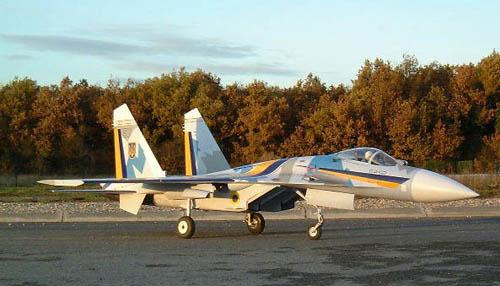
If 1:48 scale or even 1:32 scale isn't big enough for you - how about this ? A 1:8 scale FLYING model Su-27, with working jet engine, retractable undercarriage and flying surfaces. The ultimate Flanker kit !
Check out the details on their website.
| 1 | Su-27 Flanker Story by Air Fleet | ISBN 5-93511-003-2 |
| 2 | Cy-27 by Polygon | ISBN 5-88541-005-4 |
| 3 | Sukhoi Su-27 ‘Flanker’ - Aerospace superprofile | ISBN 1-874023-53-0 or ISBN 1-880588-12-9 |
| 4 | Su-27 Flanker Sukhoi Superfighter by Osprey | ISBN 1-85532-152-1 |
| 5 | Su-27 Flanker by Concord publications | ISBN 962-361-710-0 |
| 6 | Sukhoi Su-27 Flanker - Aerofax Extra No 3 | ISBN 0-942548-51-5 |
| 7 | Su-27 - PREZEGLAD KONSTRUKCJI LOTNICZYCH by Altair | |
| 8 | Military Aircraft of Eastern Europe - (1) Fighters and Ground Attack by Concord publications. | ISBN 962-361-028-9 |
| 9 | Red Star Fighters and ground Attack - Wings 8 | ISBN 1-872004-83-0 |
| 10 | Russian Warriors - Osprey | ISBN 1-85532-293-5 |
| 11 | PREZEGLAD KONSTRUKCJI LOTNICZYCH No 15 - Weapons by Altair. | ISSN 1230-2953 |
| 12 | World Airpower Journal Vol 28 & 29, Spring & Summer issues, 1997. | |
| 13 | Military Technology Special Supplement, 1995. | |
| 14 | Cy-34 by Polygon. | ISBN 5-7656-0002-6. |
| 15 | ‘OKB Sukhoi’ Published by Midland Counties. | ISBN 1 85780 0125. |
| 16 | Cy-33 'Naval Epic' by Andrei Fomin published by 'RA Intervestnik' | ISBN 5-93511-006-7 |
| 17 | Flankers - The New Generation by Yefin Gordon - published by Midland Counties - Volume 2 in their Red Star series | ISBN 1-85780-121-0 |
| 18 | International Air Power Review - Volume 8 'Focus Aircraft' | ISBN 1-880588-54-4 |
Conversion Sets :-
The Korean firm of SOL Models have produced
some
excellent conversion sets for the Academy kit to turn it into the
Su-35/37
'Super Flanker' (set number S48062), the Su-30 (set number S48065) and
the Naval Su-33 (set number S48066).
SOL Models can be found at :- http://www.hobbymnc.com/main.htm
A must to correct the Trumpeter Su-27 are the canopy, radome
& intakes from Zactomodels
Decals :-
Anna&Co ACDC 72002 'Lipetsk Shark' Su-27
Cutting Edge CED 72011 Markings for 8 a/c & CED 48011
Cutting Edge CED 72026 & CED 48024
Hi Decal 72-024 Markings for 4 a/c & 48-003
Travers 72-061 Markings for 7 a/c incl Su-30 & Su-33 (now deleted)
Travers 72-063 Markings for any one of Russian Knights a/c (now
deleted)
Propagteam 48-105
Linden Hill do
a whole range of Flanker decals - in all three scales.
Begemot Decals
have some great sheets in 1:72 scale - including new sheets of stencil data
A review of a couple of Hi-Decal Flanker sheets is here
& here
If you want to make an Indonesian Flanker - check out the decals from Scale Nutz
Resin K-36DM Seats :-
Reheat Models 48115
True Details 72401, 48404
Neomega
Airwaves 2030, 4021
KMC 485041
Verlinden 0636, 0648
Aeroclub EJ036
SOL S48057
Detail sets :-
Airwaves 4074
Eduard Su-27- 48-150, Su-27B-
48-171,
Su-34-72-203
KMC 484005
Cockpit Interior sets :-
Airwaves 2031, 2032
Falcon Industries 6003
Cutting Edge C48060
KMC 486003
Neomega-UK& NeOmega-US (for
Italeri 1:72 scale Su-27 & Su-34
Plus Academy 1:48 scale)
Airkit C055
SOL S48063 (Su-27)
SOL S48064 (Su-27UB)
Eduard do a pre-coloured
etched-brass set for Trumpeter's 1:32 scale Su-27
Bulged Tyres :-
Cutting Edge C48062
Replacement Radome :-
Quickboost now
provide an excellent resin radome/nosecone to correct the 1:72 scale
Hasegawa/Revell Su-27 kit.
Pisco have done a similar job for the 1:48 scale Academy kit -
available from Linden
Hill
Flanker Colours :-
A Quick note on Flanker Colours:-
The 'standard' VVS Su-27 Flanker colour scheme consists of pale blue
overall, with medium blue and dark-blue/grey
patches on the upper surfaces in a camouflage pattern. The exact
pattern
varies from aircraft to aircraft - but there is a
'general' pattern, even if its shape and size varies.
The following is a list of the colours matched to FS Numbers taken
from
a variety of sources -they all agree on the main colours !
| Source | Pale Blue Grey | Medium Blue | Dark Blue Grey |
| Aerofax | FS 35550 |
|
|
| Travers Decal Sheet |
|
|
|
| Hi-Decal Sheet |
|
|
|
| Travers (Russian Knights) Sheet |
|
|
|
Model Master/Testors Enamels 2130 2131 2132 are a very good. I have used them and would recommend them as the best match.
The Xtracolor Enamels - X602/X601/X603 are matched to FS
15526/FS
15450/FS 15177 respectively and are too dark.
White Ensign now do a range of the three Flanker colours - they are
excellent, although slow drying. The Dark Blue Grey is a little too
dark - probably matched from a naval Su-33 colour.
They can be found at :- White
Ensign
The Su-27IB/34/32FN/32MF has been seen in the 'standard' Su-27 colours (Su27IB), Pale Blue/Light Grey/Dark Grey (Su-34 number 43) and Dark Blue-Green/Medium Blue/Light Blue (Su-34 numbers 44 & 45). The best match for the latter colours - taken at Farnborough 2000 by Richard Ward - are :-
1. Dark Blue-Green - near to FS 35193 but a bit more green.
2. Medium Blue - near FS 35257 but a bit paler..
3. Underside Light Blue - near to FS 35466 but a bit darker and a bit
more blue.
Conclusion
This survey is as comprehensive as I can make it - and reflects my opinion only ! It is not meant to be an endorsement of any manufacturers products.
If you have any comments to make - or can add anything that I may have missed, please contact me.
Ken
Duffey
August 2002